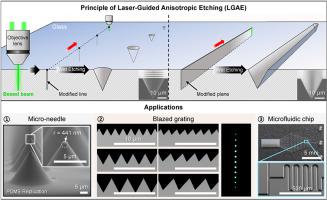当前位置:
X-MOL 学术
›
Int. J. Mach. Tool Manu.
›
论文详情
Our official English website, www.x-mol.net, welcomes your feedback! (Note: you will need to create a separate account there.)
Laser-guided anisotropic etching for precision machining of micro-engineered glass components
International Journal of Machine Tools and Manufacture ( IF 14.0 ) Pub Date : 2024-04-04 , DOI: 10.1016/j.ijmachtools.2024.104152 Jun Li , Shuai Zhong , Jiaxu Huang , Pei Qiu , Pu Wang , Hui Li , Chu Qin , Duo Miao , Shaolin Xu
International Journal of Machine Tools and Manufacture ( IF 14.0 ) Pub Date : 2024-04-04 , DOI: 10.1016/j.ijmachtools.2024.104152 Jun Li , Shuai Zhong , Jiaxu Huang , Pei Qiu , Pu Wang , Hui Li , Chu Qin , Duo Miao , Shaolin Xu

|
Micro-engineered glass components play a vital role in various domains, but their full potential remains untapped due to the lack of easily accessible high-precision machining methods for customizable microstructure. Our discovery of a new phenomenon, where laser-modified regions break the rule of inherently isotropic glass etching and regulate a directional anisotropic etching along modified tracks, has led to the development of a laser-guided anisotropic etching (LGAE) method. This method enables crafting precision glass microstructures with sharp features, smooth surfaces, and adjustable shapes and sizes. An ultrafast Bessel beam is utilized to create high aspect-ratio line-shaped modification within the glass. With a higher etching rate than pristine glass, the modified line guides directional anisotropic etching along the modified track, facilitating the formation of a V-shape with an angle altered by the etching ratio. These modified lines can further serve as basic building blocks to interconnect to construct a 3D internal modification region and then guide the glass's overall surface morphology etching evolution, enabling the creation of microstructures featuring designable shapes and adjustable feature sizes. To accurately predict and control the shape of the microstructures, we establish a finite difference etching model that incorporates localized etching rate regulation, validating the robustness and controllability of LGAE. This scalable method has successfully fabricated a 50 μm period micro-pyramid array with high uniformity over a centimeter-scale area, demonstrating its suitability for large-scale manufacturing. The showcased micro-engineered glass components encompass V-groove arrays for fiber alignment, blazed gratings for light modulation, and microchannels with customized trajectories for microfluidic chips. These advancements driven by LGAE can significantly contribute to the progress of glass-based research and industries.
中文翻译:

用于微工程玻璃部件精密加工的激光引导各向异性蚀刻
微工程玻璃部件在各个领域发挥着至关重要的作用,但由于缺乏易于实现的可定制微结构的高精度加工方法,其全部潜力尚未得到充分开发。我们发现了一种新现象,即激光修改区域打破了固有的各向同性玻璃蚀刻的规则,并沿着修改的轨迹调节定向各向异性蚀刻,这导致了激光引导各向异性蚀刻(LGAE)方法的发展。这种方法可以制作具有锐利特征、光滑表面以及可调节形状和尺寸的精密玻璃微结构。利用超快贝塞尔光束在玻璃内创建高纵横比的线形修饰。修改后的线路具有比原始玻璃更高的蚀刻速率,可以沿着修改后的轨迹引导定向各向异性蚀刻,从而有利于形成角度随蚀刻速率而变化的V形。这些改性线可以进一步作为基本构件相互连接以构建 3D 内部改性区域,然后引导玻璃的整体表面形态蚀刻演变,从而能够创建具有可设计形状和可调节特征尺寸的微结构。为了准确预测和控制微结构的形状,我们建立了包含局部蚀刻速率调节的有限差分蚀刻模型,验证了 LGAE 的鲁棒性和可控性。这种可扩展的方法已成功制造出在厘米级区域内具有高均匀性的 50 μm 周期微金字塔阵列,证明了其适合大规模制造。展示的微工程玻璃组件包括用于光纤对准的 V 型槽阵列、用于光调制的闪耀光栅以及具有用于微流控芯片的定制轨迹的微通道。 LGAE 推动的这些进步可以极大地促进玻璃研究和行业的进步。
更新日期:2024-04-04
中文翻译:

用于微工程玻璃部件精密加工的激光引导各向异性蚀刻
微工程玻璃部件在各个领域发挥着至关重要的作用,但由于缺乏易于实现的可定制微结构的高精度加工方法,其全部潜力尚未得到充分开发。我们发现了一种新现象,即激光修改区域打破了固有的各向同性玻璃蚀刻的规则,并沿着修改的轨迹调节定向各向异性蚀刻,这导致了激光引导各向异性蚀刻(LGAE)方法的发展。这种方法可以制作具有锐利特征、光滑表面以及可调节形状和尺寸的精密玻璃微结构。利用超快贝塞尔光束在玻璃内创建高纵横比的线形修饰。修改后的线路具有比原始玻璃更高的蚀刻速率,可以沿着修改后的轨迹引导定向各向异性蚀刻,从而有利于形成角度随蚀刻速率而变化的V形。这些改性线可以进一步作为基本构件相互连接以构建 3D 内部改性区域,然后引导玻璃的整体表面形态蚀刻演变,从而能够创建具有可设计形状和可调节特征尺寸的微结构。为了准确预测和控制微结构的形状,我们建立了包含局部蚀刻速率调节的有限差分蚀刻模型,验证了 LGAE 的鲁棒性和可控性。这种可扩展的方法已成功制造出在厘米级区域内具有高均匀性的 50 μm 周期微金字塔阵列,证明了其适合大规模制造。展示的微工程玻璃组件包括用于光纤对准的 V 型槽阵列、用于光调制的闪耀光栅以及具有用于微流控芯片的定制轨迹的微通道。 LGAE 推动的这些进步可以极大地促进玻璃研究和行业的进步。



























 京公网安备 11010802027423号
京公网安备 11010802027423号